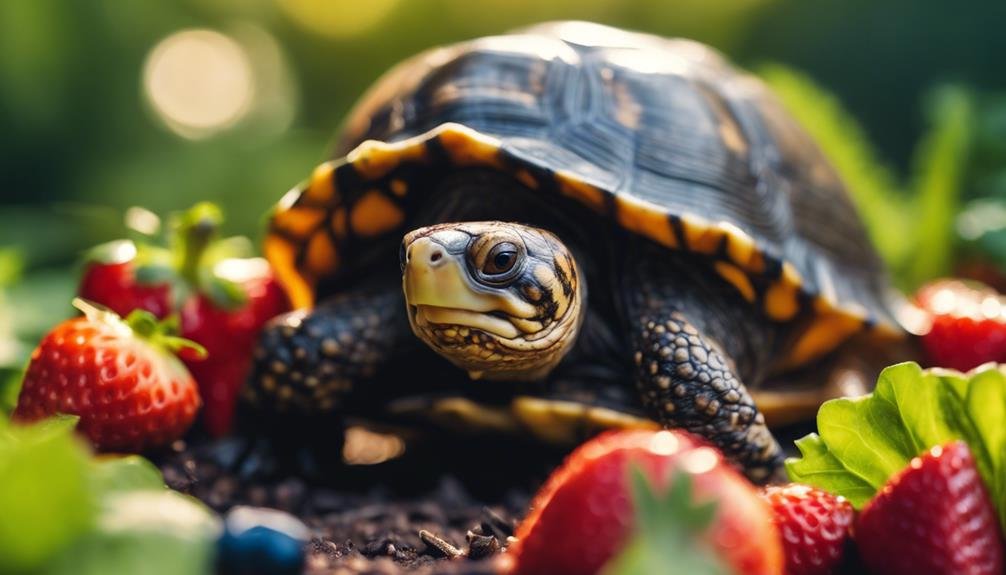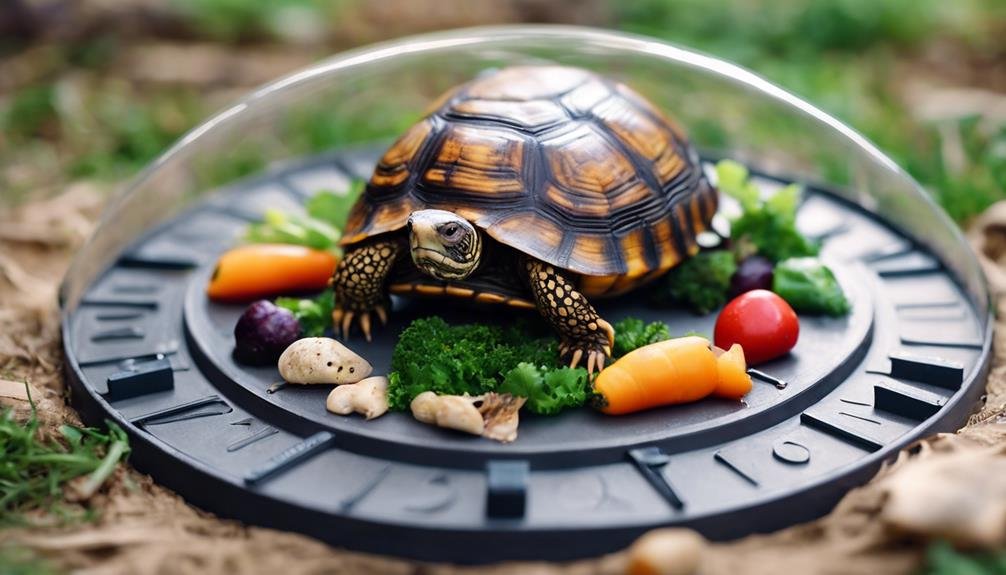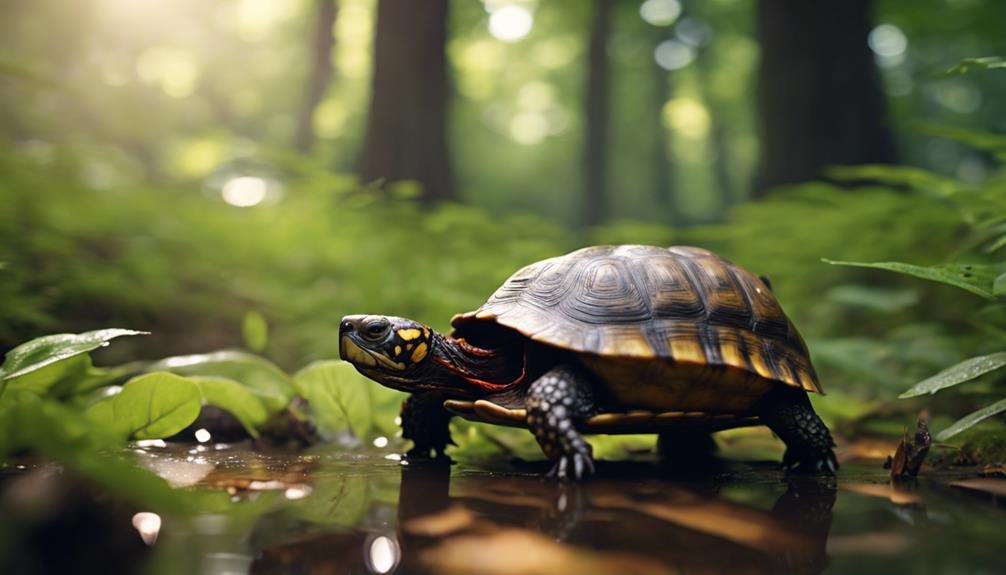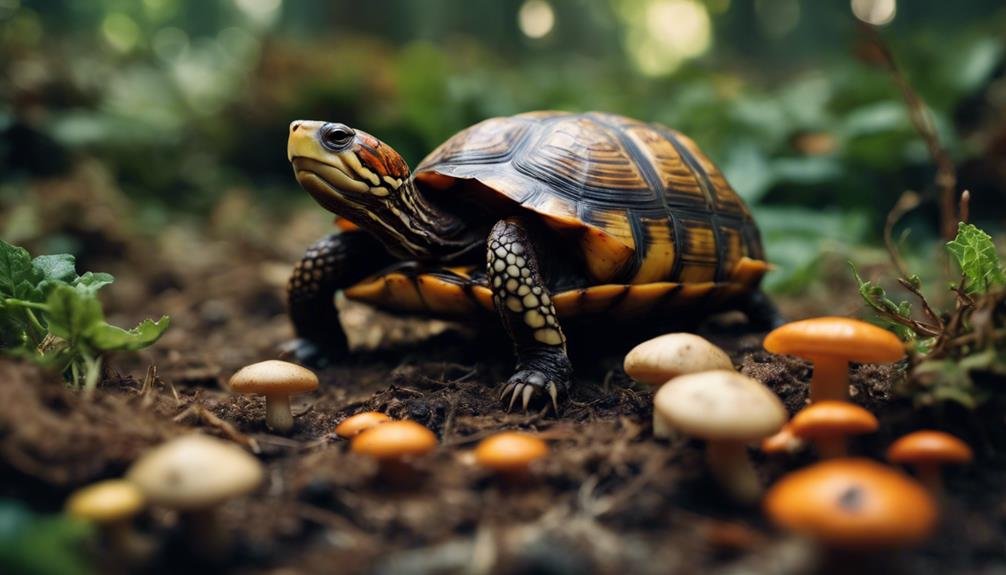You might think feeding your box turtle is as simple as tossing a few lettuce leaves into their habitat, but their dietary needs are more complex and varied than that. In the wild, box turtles’ diets consist of a mix of animal and plant materials, which means they’re omnivores. They need a balance of proteins, like worms and insects, along with a variety of fruits and vegetables to meet their nutritional needs. But what exactly should you feed them to make sure they’re getting the right nutrients, and how does their diet change with age? Let’s explore the best diet that keeps a box turtle healthy and thriving.
Key Takeaways
- Box turtles consume insects, worms, snails, fruits, and vegetation in the wild.
- They require a balanced intake of calcium and phosphorus for optimal health.
- Dark leafy greens, Chinese cabbage, and green beans are recommended vegetable choices.
- Essential protein sources include grasshoppers, crickets, mealworms, and eggs.
- Fruits like blackberries and raspberries should be fed in moderation due to sugar content.
Natural Diet in the Wild
In the wild, box turtles enjoy a diverse diet that includes insects, worms, snails, fruits, berries, and an array of vegetation. As you explore the natural habits of these turtles, you’ll find they’re not just casual diners; they require a mixed diet to thrive. This balanced diet, split between animal and plant matter, is vital for their health.
Leafy greens, a staple in their consumption, are foraged along with a variety of fruits that provide essential vitamins. Insects, which form a significant part of their diet, offer protein and fats necessary for energy and growth. This blend of nutrition sources ensures that box turtles maintain a balanced diet that supports their complex nutritional needs.
While wandering the forest floor, box turtles opportunistically feed on what’s available, from mushrooms to small, live prey. This natural behavior supports their instinctual needs and health, emphasizing the importance of a varied and balanced diet. As you consider their dietary habits, remember that the diversity of fruits, leafy greens, insects, and other vegetation they consume is key to their survival and well-being in the wild.
Essential Nutrients for Box Turtles
You’ll need to make sure your box turtle’s diet is rich in calcium and low in phosphorus to maintain their best health. Striking the right balance between calcium and phosphorus is vital, as a high phosphorus ratio can inhibit the absorption of calcium, leading to health issues like shell deformities and weak bones.
Incorporating quality protein sources is also essential. Items such as insects and cooked eggs provide the necessary building blocks for muscle development and growth. But remember, it’s not just about protein; the types of plants you offer are important, too. Dark leafy greens are excellent sources of calcium and should be a regular part of their diet. These greens, along with a careful selection of other plant-based foods, help ensure they’re not only getting calcium but a spectrum of other nutrients as well.
Don’t overlook the importance of vitamin A, particularly for their eye health and immune function. Making sure your turtle receives enough of this vitamin can prevent serious health issues.
To end, hydration plays a pivotal role in their overall health, supporting digestion and nutrient absorption. Always keep fresh water accessible and monitor their intake.
Recommended Fruits and Vegetables


What variety of fruits and vegetables should you include in your box turtle’s diet to guarantee excellent health? It’s important to provide a mix that delivers essential nutrients and maintains your pet’s well-being.
Start with dark leafy greens, which are crucial. Collard greens and kale top the list for their nutrient density, offering a robust source of vitamins and minerals. Don’t overlook Chinese cabbage either, as it’s another excellent green that supports overall health. To round out the vegetables, include green beans and beet tops, both of which contribute additional vitamins and fiber.
When it comes to fruits, you’ll want to be a bit more selective. Blackberries and raspberries are fantastic choices, but remember to feed them in moderation. These berries add a nice variety to the diet and provide essential antioxidants, but their sugar content means they shouldn’t be the mainstay.
Protein Sources for Box Turtles
Box turtles need a variety of protein sources, such as grasshoppers, crickets, mealworms, and eggs, to maintain a balanced diet. Including these protein foods ensures that your turtle gets the necessary nutrients for healthy development and longevity. It’s important to diversify their diet with both animal-based and plant-based items for best health.
Commercial reptile pellets also offer a convenient and balanced protein source. These pellets are formulated to meet the nutritional needs of box turtles and can be a good supplement to live prey and other natural protein sources. However, you’ll want to make sure these pellets are high quality and specifically designed for turtles.
Here’s a table to help you understand some common protein sources for box turtles:
| Protein Source | Type | Note |
|---|---|---|
| Grasshoppers | Live insect | High in nutrients, breed indoors |
| Crickets | Live insect | Easily available, use trusted sources |
| Mealworms | Live insect | Nutrient-rich, make sure they are clean |
| Commercial Pellets | Processed food | Convenient, make sure they’re for turtles |
Avoiding Harmful Foods


To keep your box turtle healthy, avoid feeding them toxic plants and foods like ivy, rhubarb, and avocado. These substances can harm your pet, causing serious health issues. Additionally, you’ll need to steer clear of other harmful foods, including chocolate, caffeine, dairy products, and all processed foods. These aren’t naturally part of a box turtle’s diet and can lead to digestive and health complications.
When planning your turtle’s diet, focus primarily on green vegetables and other fruits and vegetables that are safe and nutritious. However, be cautious with items high in oxalates, such as spinach and certain berries, as they can bind to calcium and hinder its absorption, potentially leading to deficiencies. Instead, opt for safer choices like carrots, squash, and apples.
Also, avoid high-sugar foods, salty snacks, and high-fat foods. These include candy, chips, fried foods, and fatty meats, which are inappropriate for your turtle’s health. Such items don’t provide the nutritional balance your turtle needs and can lead to obesity and other health issues. Remember, a balanced diet, rich in appropriate fruits and vegetables, is essential for maintaining your turtle’s health and vitality.
Supplements and Vitamins
While prioritizing the right foods is important, you also need to make sure your box turtle gets enough vitamins and supplements for peak health. A key concern is ensuring they receive proper calcium supplementation to avoid metabolic bone disease, a common issue among captive turtles. This disease can severely affect their bone health, leading to painful and debilitating conditions.
To manage this, it’s important to include a well-balanced reptile calcium and multivitamin supplement in their diet. Vitamin D3 plays a significant role here, as it helps in the metabolism of calcium, ensuring that the calcium they ingest is effectively absorbed and utilized. Without adequate vitamin D3, your turtle may suffer from calcium deficiencies, even if their diet is rich in calcium.
You can easily administer these important nutrients by dusting their food with calcium powder a few times a week. However, the exact frequency and amount will depend on their specific diet and housing conditions— factors like natural sunlight exposure and the variety of foods they consume can influence their supplement needs. Remember, a balanced approach to their nutrition is key to fostering a healthy, active turtle.
Feeding Schedule and Portions


Understanding how frequently and how importantly to feed your box turtle is vital for their health and well-being. Adult box turtles should be fed three or more times a week, preferably in the morning. This feeding schedule helps maintain their overall health. In contrast, juvenile box turtles, due to their higher protein requirements, need daily feeding.
When preparing their meals, you’ve got to balance their diet to meet their specific nutritional needs. Aim for 50% animal or high-protein foods, 25% fruits, and 25% vegetables. This blend ensures they receive a wide range of nutrients essential for their growth and health.
It’s also essential to supplement their food with calcium and multivitamins. Dust their food with either calcium lactate, carbonate, or gluconate at each feeding to make sure they’re getting enough calcium for strong bones and proper bodily functions. Additionally, dust their food with multivitamins every one to two weeks to cover any nutritional gaps.
Handling Feeding Difficulties
Despite your best efforts to follow a balanced feeding schedule, you might find that your box turtle occasionally refuses to eat or shows a preference for certain foods. When this happens, it’s important to address these feeding difficulties with patience and a few strategic adjustments to their diet and feeding habits.
Here are some tips to help manage and overcome feeding challenges with your box turtle:
- Offer food during active times: Turtles are more likely to eat when they’re most active. Identify these times and try feeding your box turtle then to stimulate their appetite.
- Mix favorite foods: If your turtle favors certain vegetables, mix these preferred items with other nutritious foods to encourage a more balanced diet.
- Rotate food items: Avoid giving the same vegetables every day. Rotating different items can prevent your turtle from developing food aversions.
- Introduce new foods gradually: Incorporate new foods into your box turtle’s diet slowly to allow them to adjust without overwhelming them.
- Check food sizes: Make sure the pieces are appropriately sized to make them easier for your box turtle to consume.
Implementing these strategies should help your box turtle overcome their feeding difficulties and maintain a healthy and varied diet.
Ideal Environmental Conditions


To ensure your box turtle thrives, maintain daytime temperatures between 70-85°F and nighttime temperatures at 65-75°F. This range closely mirrors their natural habitat, ensuring comfort and health. Pair this with a humidity level of 60-80% to avoid dehydration and keep their shell in top condition. It’s essential you’ve got a setup that includes a water bowl large enough for them to soak if they wish, as this helps maintain the humidity and hydration.
Don’t forget to offer a balanced diet of green plant material, vegetables, and fruits, ensuring a proper calcium to phosphorus ratio to prevent metabolic bone disease. UVB lighting is critical in this setup; it aids in the metabolism of calcium, which is important for their health. This light, combined with the right diet, supports their overall well-being.
Make sure their enclosure has plenty of hiding spots and a substrate suited for burrowing, as this simulates their natural environment and reduces stress. Regular cleaning is essential; it prevents harmful bacterial and fungal growth, keeping your turtle healthy. Remember, a clean, well-structured habitat is key to a happy, healthy box turtle.
Can Baby Turtles Eat the Same Food as Adult Box Turtles?
Yes, baby turtles can eat the same food as adult box turtles, but in smaller portions. It’s important to consider baby turtles feeding habits when providing them with food. Their diet should consist of protein-rich foods such as insects, worms, and small fish, along with fruits and vegetables.
Sourcing Quality Turtle Food
Prioritizing quality and safety when sourcing food for your box turtle is vital to promote their health and longevity. When planning your box turtle’s diet, it’s crucial to guarantee you’re feeding only organic or thoroughly rinsed produce to minimize the risk of pesticide exposure.
Here are some key guidelines for sourcing quality turtle food:
- Feed Organic: Whenever possible, feed your box turtle organic fruits and vegetables. If organic isn’t available, make sure to wash conventional produce thoroughly.
- Diverse Diet: Include a variety of foods a few times a week to maintain a balanced diet. This can include leafy greens, insects, and occasional fruits.
- Safe Foraging: If you allow your box turtle to forage in your backyard, make sure the area is free from pesticides and other chemicals.
- Reputable Sources: Buy feeder insects from reputable dealers to avoid the risk of contamination with pesticides or other harmful substances.
- Nutritional Supplements: Consider adding supplements to their diet to guarantee they receive all necessary nutrients, especially calcium and vitamin D.
Conclusion
To sum up, ensuring your box turtle thrives means offering a varied diet rich in insects, worms, dark leafy greens, and berries. Balance their intake of calcium and phosphorus, and incorporate quality proteins like insects and occasional eggs.
Avoid harmful foods and stick to a regular feeding schedule. Address any feeding issues promptly and maintain the right environmental conditions. By sourcing quality food and monitoring their diet, you’ll keep your box turtle healthy and happy.


